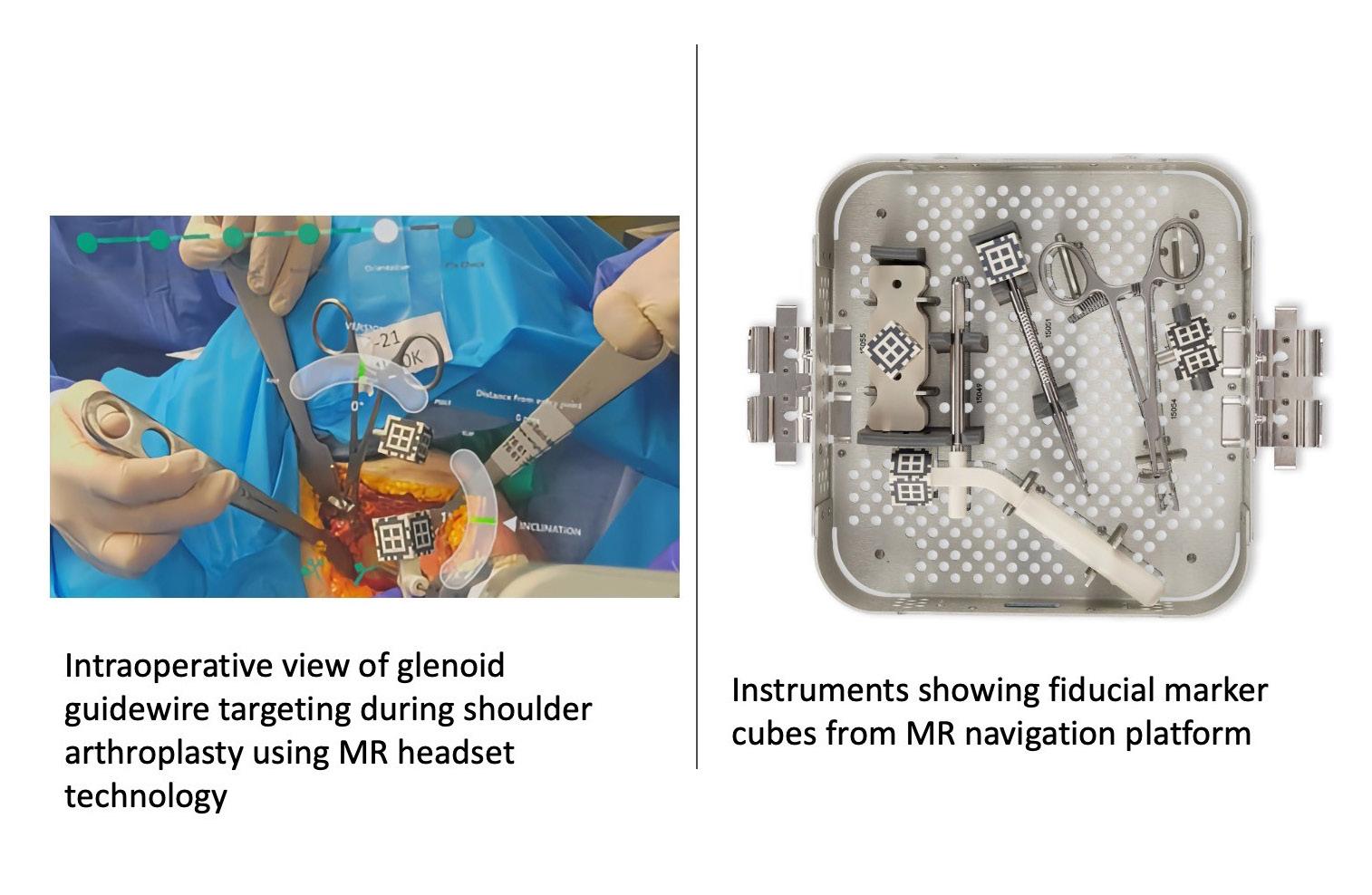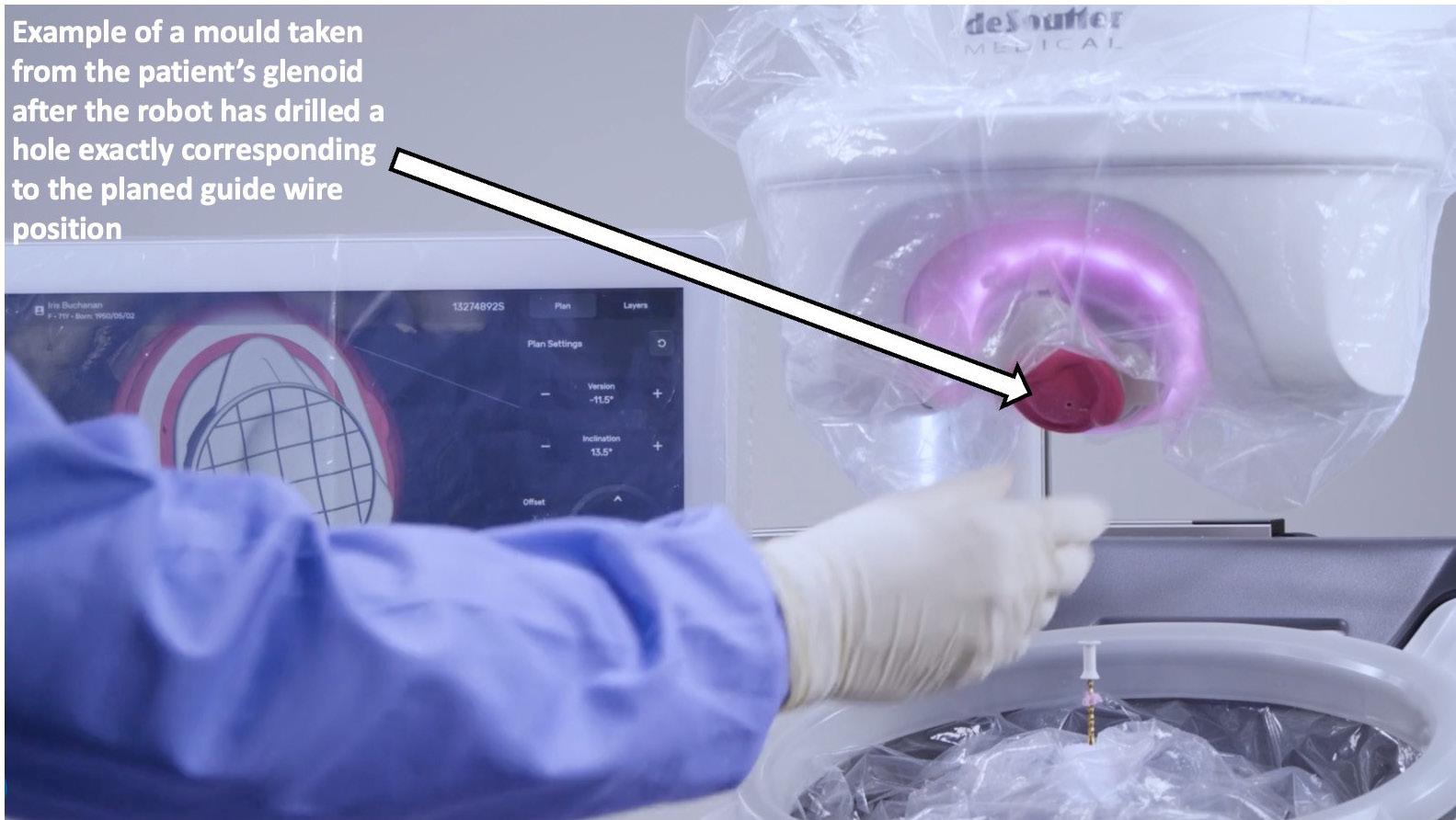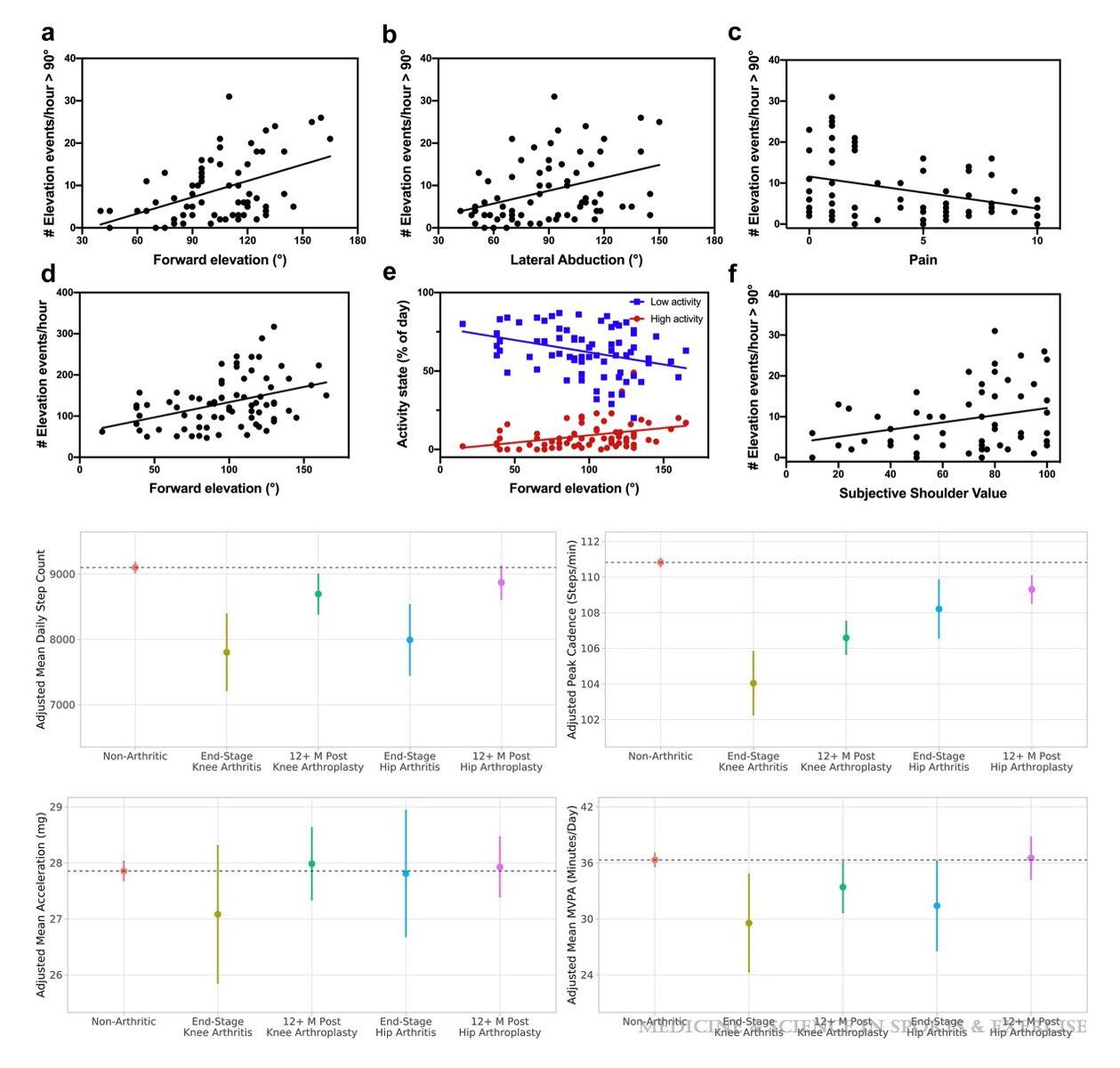
11 minute read
A tipping point for technology in shoulder surgery?
John McNamara, Matthew Williams and Simon Hurst
In 2009 at Harvard’s annual arthroplasty meeting, industry was showcasing its latest product offerings, amongst them Brainlab™ showing early iterations of navigation. The possibilities appeared unlimited with a broad range of uses demonstrated from navigating a distal locking screw in a tibial nail to aiding acetabular component positioning in hip resurfacing. One of the authors was there and spent some time lining up various cross hairs at the stand, it felt like the future had arrived. There was nothing yet for the shoulder, but it was surely only a matter of time.
Big bang theory
15 years ago, technology in orthopaedics was enjoying its ‘first coming’. Commercial spaces were filling with navigation systems allowing for more precise positioning of cutting blocks, guide pins, entry points and screws. The very concept of navigation itself implies that one has a destination in mind - or the correct position – and so it also came in lockstep with planning software.
The overriding principle was to reduce outliers, surgeons with lower annual numbers of a procedure type, those in training, or for use in procedures which might be considered to have a narrower window of tolerance for malposition.
Robotic systems such as Justin Cobb’s (Imperial College, London, UK) novel Acrobot™ arrived onto the scene [1]. Technology in this form didn’t compete with existing portfolios, because if you wanted to use their technology for navigation you usually had to use the company’s respective implant. With implants placed more accurately there was also the prospect of lower revision rates and improved registry data.
Mako™ went one step further and designed a totally new implant to work with their robotic system for uni-compartmental knee replacement. In this setting it was easy to see and imagine the future. Arthroplasties would all be planned with subsequent execution of the plan using either a navigation or robotic platform. Except it really didn’t quite work out that way. Yet…
Hype and suspicion
As surgeons, we strive to be evidence-based and outcome orientated. This rightly creates natural suspicion and resistance to any deviation from habitual techniques and established technology. After all, it took some 45 years, and significant criticism, for Palmer’s initial laparoscopic techniques in the 1940s, to culminate in the first laparoscopic cholecystectomy in 1985. A technique which paved the way for similar methods, including shoulder arthroscopy within our own specialty.
Perhaps stronger than this is an innate resistance to change something that appears to all intents and purposes to be working. The navigation and robotic systems of that period arrived and in some instances were wrecking balls, disrupting flows, and forcing surgeons to amend techniques long perfected. As a result, cases took considerably longer, and there was sometimes abandonment to traditional techniques midcase. This accompanied by the need to insert navigation pins, alongside time consuming registration procedures and occasional equipment malfunctions led people to persist for a few cases but many then simply gave up.
A strength of industry is often to inspire us to do something new. But with the associated hype comes a risk of over promising and under delivering. Many will try something, but will they become adopters? After they have tried and failed to adopt, a window is then shut for a period. This is usually until that individual decides that something fundamental has changed and is as a result willing to try it anew. In this way, technology’s ‘first coming’ ended up being predominantly left to the enthusiasts.
A paradigm shift in commercial models and technology’s second coming
The recent Cumberlege enquiry, GIRFT movement, and increased regulation and costs associated with new implant development have shifted the balance away from implant innovation in favour of doing what we know works well, better.
This has led to a paradigm shift away from developing new implants, towards increasing the yield from current implant portfolios. In this environment, we see money being directed towards investment in technologies to support the use of existing implants.
This has led to substantial refinement in planning, navigation and robotic platforms and the emergence of several new domains: mixed reality (MR) headsets, 3D printed guides, and wearable devices amongst many others.
Many trainees have had exposure to these technologies during their training and will be looking to incorporate them into their practice. For those who tried the initial inceptions of navigation and robotics and didn’t become adopters it is likely that enough time has passed for many to be open to re-visiting latest iterations. This combined with a natural awareness and acceptance of technology into our lives outside of the workplace makes fertile ground for a ‘second coming’ of technology into the orthopaedic space.
Watch this space
Mixed reality
Mixed reality (MR) technology (a slightly more immersive version of augmented reality) allows for a digital image in 3D holographic form to be both superimposed and controlled by the user on top of their normal visual field. In surgery, it is easy to see the potential in projecting visual information in this way without compromising sterility.
As a result, there has been significant investment towards developing software for these devices. Microsoft’s Hololens™ arrived in 2016 and a year later, a first shoulder replacement was performed by Thomas Gregory at Avicenne Hospital, APHP, Paris, France using visual holographic aids [2]. Zimmer Biomet has since adapted the later version of the headset, the Hololens™ 2 for surgery with their Optivu™ system including an inbuilt camera tilt amongst other features for surgery.
At present most of the large manufacturers have their own MR packages. Almost all use the Microsoft Hololens™ 2 platform, itself launched in 2019 and already five-years old with focus to date being predominantly within domains of planning, MR adjuncts to traditional navigation, and remote assistance.
As with navigation and robotics in the late noughties, this hasn’t quite taken off yet, which likely comes down to the concept of genuine utility. Many products launched to date have made for interesting and visually compelling demonstrations during surgery but have objectively added little. They improve conceptualisation and allow for others to view remotely, but only like any other head mounted camera, furthermore MR headsets can even remove acuity from the visual field akin to wearing sunglasses.
Despite these challenges, we believe that MR will have an enormous role to play. Some hurdles in providing a smoothly functioning MR navigation system have been overcome by Stryker’s Blueprint™ software (Figure 1) [3].
An emergence of newer MR devices such as Apple’s Vision Pro™, and Google Glass™ provides an opportunity to develop software, taking advantage of their enhanced capabilities.
A key domain for focus should be in remote surgical assistance. The ultimate goal being to develop technology around accurate holographic representation of another surgeon’s hand in the visual field of another operating remotely. The possibilities of being able to accurately point and gesticulate to another remotely being easy to comprehend.
To maximise the likelihood of surgeons becoming adopters, functionality in this domain must be shown to have genuine surgical utility. New users must be properly trained and logistics (including the banalities of charge times, internet bandwidth, and DICOM data management) must be seamless.
Novel robotic platforms
The core concepts of robotic platforms around supporting the precise execution of surgical plans are well established as a navigation adjunct with a robotic arm aiding guide wire position or the preparing of a bony surface in preparation for an implant. Custom guides provide an alternative but can take weeks to manufacture with 3D printing not yet providing a robust solution when the negative effects of autoclave sterilisation are considered.
In shoulder arthroplasty, De Soutter’s CelitoTM robotics platform represents a way of rapidly manufacturing guides using a robotic platform. A truly novel technique whereby a mould is taken by the surgeon of the glenoid surface using a special cartridge. The mould cartridge then sets and the robot which is within the sterile field uses an optical scanner to scan the mould taken and map to cross sectional imaging of the patient. It then drills a hole corresponding to the planned guide wire position, (Figure 2), allowing for an angular accuracy of 1.9 degrees version and 1.2 degrees inclination with a positional accuracy of 1.1mm when compared to the preoperative plan [4]. As upper extremities often represent a smaller market share, they usually end up with technology extrapolated from the hip and knee world. The rapid on table manufacture of guides using this robotic technique, is an example of innovation in the other direction and one could imagine its use outside of the shoulder.
Wearable devices
Wearable technology is the use of sensors attached to a patient, which can detect and record movement, or other variables. This technology in society is common, existing in devices such as smart phones or accelerometers and its use is increasing.

This has created a natural opportunity to monitor patients and observe progress following injury, therapy or surgery. A global poll of AO Trauma members found that 21% of respondents use wearable technology in clinical treatment, the largest proportion of these were used in the upper limb.
Researchers have already started to track return of movement following shoulder surgery and are even able to monitor sleep quality as a marker of pain following arthroplasty. Many groups are showing an increase in patient recovery from injury and surgery with the addition of a wearable [5]. The data types that can be obtained is both novel and compelling with the ability to be used alongside PROMS and other data to provide a more complete picture (Figure 3) in the outcomes of surgery [6].

Wearables will offer real time updates to the surgeon, therapist and patient for range of movement, recovery and discomfort. This will allow detailed remote monitoring and early identification of outliers. In the non-elective setting, data collected from a wearable provides opportunity to show when patient function returns following fracture. This in turn, providing feedback to clinicians to initiate progress to load bearing such as for clavicle or proximal humerus fractures. With wearable technology becoming ubiquitous in modern society, the clinical implications of this are unlimited.
Conclusions
A favourable financial climate for technology more generally is being created by the predicted force of artificial intelligence (AI) being introduced across our health systems. With this second coming of technology will come a responsibility of all of us to conduct rigorous examination of these technologies and decide whether they provide genuine utility for our patients. The UK has a proud tradition being a world leader in orthopaedic research with a particular focus on high quality RCTs which have shaped contemporary practice.
Has the low hanging fruit from RCTs already been harvested? If so we may see less impact from them over the coming years as conducting them at a global scale becomes more time consuming, logistically complicated and expensive [7].
As technology reaches a tipping point in shoulder surgery this should provide space and impetus for both its further development and assessment; a premise that technology must never be used for its sake alone.
References
1. Cobb J, Henckel J, Gomes P, Harris S, Jakopec M, Rodriguez F, et al. Hands-on robotic unicompartmental knee replacement: a prospective, randomised controlled study of the acrobot system. J Bone Joint Surg Br. 2006;88(2):188-97.
2. Gregory TM, Gregory J, Sledge J, Allard R, Mir O. Surgery guided by mixed reality: presentation of a proof of concept. Acta Orthop. 2018;89(5):480-3.
3. Fleet CT, Gao R, Johnson JA, Athwal GS. An in vitro comparison of mixed-reality navigation to traditional freehand and patient-specific instrumentation techniques for glenoid guide pin insertion during shoulder arthroplasty. J Shoulder Elbow Surg. 2024;33(11):2482-92.
4. Darwood A, Hurst SA, Villatte G, Tatti F, El Daou H, Reilly P, et al. Novel robotic technology for the rapid intraoperative manufacture of patient-specific instrumentation allowing for improved glenoid component accuracy in shoulder arthroplasty: a cadaveric study. J Shoulder Elbow Surg. 2022;31(3):561-70.
5. Small SR, Khalid S, Price AJ, Doherty A. Device-Measured Physical Activity in 3506 Individuals with Knee or Hip Arthroplasty. Med Sci Sports Exerc. 2024;56(5):805-12.
6. Van de Kleut ML, Bloomfield RA, Teeter MG, Athwal GS. Monitoring daily shoulder activity before and after reverse total shoulder arthroplasty using inertial measurement units. J Shoulder Elbow Surg. 2021;30(5):1078-87.
7. Costa ML, Brealey SD, Perry DC. International orthopaedic trials. Bone Joint J. 2023;105-B(7):719-22.










